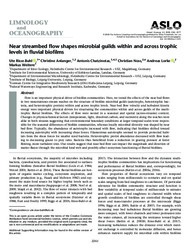Near streambed flow shapes microbial guilds within and across trophic levels in fluvial biofilms
Anlanger, Christine
Chatzinotas, Antonis
Noss, Christian
Weitere, Markus
DOI: https://doi.org/10.1002/lno.11451
Persistent URL: http://resolver.sub.uni-goettingen.de/purl?gldocs-11858/9260
Persistent URL: http://resolver.sub.uni-goettingen.de/purl?gldocs-11858/9260
Risse-Buhl, Ute; Anlanger, Christine; Chatzinotas, Antonis; Noss, Christian; Lorke, Andreas; Weitere, Markus, 2020: Near streambed flow shapes microbial guilds within and across trophic levels in fluvial biofilms. In: Limnology and Oceanography, Band 65, 10: 2261 - 2277, DOI: 10.1002/lno.11451.
 |
Dokument öffnen: |
Flow is an important physical driver of biofilm communities. Here, we tested the effects of the near bed flows in two mountainous stream reaches on the structure of biofilm microbial guilds (autotrophs, heterotrophic bacteria, and heterotrophic protists) within and across trophic levels. Near bed flow velocity and turbulent kinetic energy were important physical drivers for structuring the communities within and across guilds of the multitrophic fluvial biofilms. The effects of flow were nested in a seasonal and spatial (across-streams) context. Changes in physicochemical factors (temperature, light, dissolved carbon, and nutrients) along the reaches were alike in both streams suggesting that environmental boundary conditions at larger temporal scales were responsible for the seasonal differences of biofilm communities, whereas locally microbial diversity was shaped by near bed flow. Typically, the abundance of autotrophs increased with flow, indicating that biofilms shifted toward increasing autotrophy with increasing shear forces. Filamentous autotrophs seemed to provide protected habitats from the shear forces for smaller sized bacteria. Heterotrophic protist abundance decreased with flow leading to decreasing grazer to prey ratio. Bacteria thus benefitted from a reduction in grazing pressure at faster flowing, more turbulent sites. Our results suggest that near bed flow can impact the magnitude and direction of matter fluxes through the microbial food web and possibly affect ecosystem functioning of fluvial biofilms.
Statistik:
ZugriffsstatistikSammlung:
This is an open access article under the terms of the Creative Commons Attribution-NonCommercial-NoDerivs License, which permits use and distribution in any medium, provided the original work is properly cited, the use is non-commercial and no modifications or adaptations are made.

